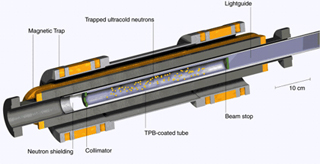-

-
Find Courses
Collections
Cross-Disciplinary Topic Lists
- About
- Donate
- Featured Sites
This is an archived course. A more recent version may be available at ocw.mit.edu.

Half section view of an ultracold neutron trapping apparatus. The trap is loaded through inelastic scattering of col d neutrons (11 K) with phonons in superfluid helium-4. Trapped neutrons are detected when they beta decay; energetic decay electrons ionize helium atoms in the superfluid resulting in efficient conversion of electron kinetic energy into light (scintillation). (Image courtesy of NIST.)
Prof. Jeffrey Coderre
22.01
Fall 2006
Undergraduate
This course provides an introduction to the basic properties of ionizing radiations and their uses in medicine, industry, science, and environmental studies. We will discuss natural and man-made radiation sources, energy deposition and dose calculations, and various physical, chemical, and biological processes and effects of radiation, with examples of their uses, and principles of radiation protection.
OCW has published multiple versions of this subject. ![]()
Archived versions: ![]()
Jeffrey Coderre. 22.01 Introduction to Ionizing Radiation. Fall 2006. Massachusetts Institute of Technology: MIT OpenCourseWare, https://ocw.mit.edu. License: Creative Commons BY-NC-SA.
For more information about using these materials and the Creative Commons license, see our Terms of Use.
